Nigella’s Cook, Eat, Repeat episode 3: Nigella shares her go-to celebratory cake – a divine, layered chocolate and peanut butter cake that will make even die-hard haters of peanut butter relent. She goes on to create a colourful rainbow dish of vegetables and spiced bulgur wheat, suitable for vegans, vegetarians and anyone who wants a tasty dish with minimal effort.
Alternative video stream
There are some new additions to Nigella’s liquorice toolbox, one of which provides the key element for a sauce to accompany her Basque burnt cheesecake. Nigella shares the rhythms and rituals of her kitchen and reveals the inspiration behind many of her recipes.
Nigella’s Cook, Eat, Repeat episode 3 recipes:
Basque burnt cheesecake with liquorice sauce
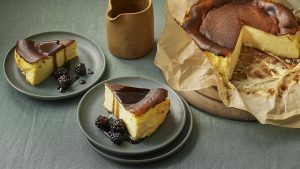
I just can’t stop making this. A lover of all cheesecakes, in every one of their manifestations, I had – I must admit – neither eaten nor heard of this until a few years ago. It is, I should say, very easy to make. There’s no crust, it’s just a wodge of tangy cheesecake that, although burnt on top, is only barely set in the middle. The hard thing is learning to take it out of the oven when it feels undercooked.
Method
- Preheat the oven to 200C/180C Fan/Gas 6. Get out a 20cm/8in springform tin and a roll of baking paper. Unfurl a long piece from the roll, and when it looks like you’ve got enough to line the tin with an overhang of 5–7cm/2–2¾in, tear it off and press into the tin and down into the edges at the bottom. Now do the same again with a second piece, placing it perpendicular to the first so that the tin is entirely lined. Push this piece down too and don’t worry about any pleats, creases and wrinkles; this is The Look. Sit something heavy in the tin to keep the paper in place while you get on with the cheesecake mixture.
- I use a freestanding mixer fitted with the flat paddle for this, but you could easily use a large bowl, wooden spoon and elbow grease. First beat the cream cheese with the sugar until light and smooth; I beat for quite a long time, certainly not under 2 minutes and it would be at least 5 minutes by hand. It is absolutely essential – and I’m sorry to repeat myself – that the cream cheese is at room temperature before you start.
- Beat in the eggs, one at a time, waiting for each one to be incorporated before adding the next. When they’re all mixed in, pour in the soured cream, beating all the while. Once that is also incorporated, you can slow down the mixer a little (or risk getting cornflour all over yourself) and then beat in the salt, followed by the cornflour, a teaspoon at a time. Remove the bowl from the mixer, scrape down the sides with a silicon spatula and give everything a good stir.
Method part 2
- Pour into the lined tin (removing whatever’s been sitting in it, obviously), making sure no cheesecake mixture is left in the bowl. Rap the filled tin on the work surface about five times to get rid of any air bubbles.
- Place in the oven and bake for 50 minutes, until the cheesecake is burnished bronze on top, even chestnut brown in places, and risen, like a dense soufflé. It will, however, still be very jiggly. It’s meant to be. You’ll think it’s undercooked, but it will carry on cooking as it cools, and it should have a soft set anyway.
- Transfer the tin to a wire rack and leave to cool. It will sink in the middle a little, but that too is part of its traditional appearance. I reckon it’s cool enough to eat after 3 hours, although you may need to leave it for a little longer. If you want to chill it in the fridge, do, but not for more than 30 minutes.
- Make the liquorice sauce once the cheesecake is out of the oven. If you have a bullet blender, you can pulverise the liquorice pellets first. Place the liquorice in a small saucepan with 300ml/10fl oz water. Stir in the sugar, then place over a low heat until the liquorice has all but dissolved, stirring to give it a bit of a nudge every now and again to help it melt. Turn up the heat and let it bubble away until reduced to 150ml/5fl oz – turning the heat down a bit if it looks like it’s boiling over. I find this can take up to 20 minutes. Stir in a pinch of salt, if using, and leave to cool. It will have the texture of a syrup, which in effect, it is. Transfer to a serving jug.
- Before serving, unclip and lift the sides of the tin up and away, and then lift the cheesecake up with the edges of the paper. Place this on a board and peel the paper back. Take it like that, rustically beautiful, to the table, along with the blackberries and the even blacker liquorice syrup. Just drizzle a little over the slices of cheesecake as you hand them out, allowing hard-core liquorice lovers to spoon more over as they eat.
Spiced bulgur wheat with roast vegetables – Nigella’s Cook, Eat, Repeat episode 3
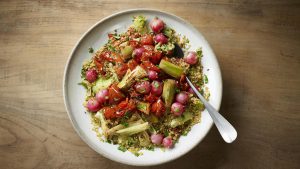
This is one of my most repeated suppers, particularly when I have vegetarian or vegan friends over, but not only then; even meat-eaters do not need to eat meat every day. And while it’s certainly enough for four, I don’t decrease quantities for two; this is most definitely something you want in a tub in the fridge to eat later in the week, whether reheated or as a salad.
Method
- To make the bulgur wheat, very gently heat the oil in a heavy-based casserole over a low heat and stir the orange zest into the oil. Add the garlic and the finely chopped coriander stalks and stir these into the oil for about 30 seconds. Turn the heat up a little, just to medium–low, and add the fennel, cumin and coriander seeds, followed by the chilli flakes, and give everything a good stir.
- Turn the heat up to high and quickly add the bulgur wheat and lentils. Stir again well to make sure everything is mixed together. Now add 375ml/13fl oz cold water and the salt and bring to the boil. Once it’s started bubbling, clamp on the lid, turn the heat back down to low and leave to cook gently for 15 minutes, or until all the water is absorbed. Turn off the heat, cover the pan with a clean tea towel, clamp the lid back on and leave for 40 minutes (though it will stand happily for a lot longer than this, I routinely leave this for 2 hours).
- To make the roast vegetables, preheat the oven to 220C/200C Fan/Gas 7. Drop the leeks into a sturdy and fairly shallow roasting tin in which, ideally, all the vegetables will sit snugly; I use one that is 29x25x5cm/11½x10x2in. Add the peppers and cherry tomatoes to the roasting tin. Sprinkle the seeds and salt over the vegetables, add the oil and schmoosh to mix. Pour 2 tablespoons of cold water and 2 tablespoons of orange juice into the tin and roast in the oven for 30 minutes, until the vegetables are soft and the leeks are beginning to scorch.
Method part 2
- Add the radishes and mix. As the vegetables – ideally – fit so snugly in their tin, they make a wonderful, strongly flavoured sauce as they cook. However, if you’ve had to use a bigger tin, you may find that they’re going a little dry and might be sticking to the tin in places. If so, add another tablespoon each of orange juice and water or more as needed. Put back in the oven to roast for another 10 minutes then leave to stand while you put the finishing touches on the bulgur wheat..
- Remove the lid and tea towel from the bulgur wheat and use a couple of forks to mix everything together in the pan and, importantly, to separate and fluff up the grains. Tip into a serving bowl or dish, add most of your chopped coriander leaves and fork it in. Add a third of the roast vegetables and mix in well but lightly with the forks. Taste for seasoning – I often want to add more salt at this stage. Top with the remaining roasted vegetables and sprinkle with the rest of the coriander.
Chocolate peanut butter cake – Nigella’s Cook, Eat, Repeat episode 3
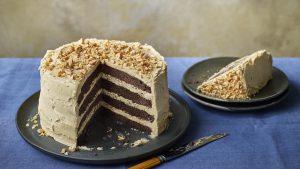
Over the years, I have made many different cakes for my children’s birthdays. But for some time now, this has been the chosen one, the cake of cakes, elected to grace many special occasions – and with good reason.
Method
- Preheat the oven to 180C/160C Fan/Gas 4. Grease 4 x 20cm/8in ultra-shallow layer cake tins and line them with baking paper. Don’t use loose-bottomed tins as this is a runny batter.
- Cut the butter lengthways into four pieces (just to aid melting), place in a heavy-based, fairly wide saucepan and set over a gentle heat. Add the just-boiled water and whisk in the cocoa and the sugars. Whisk gently until the butter has melted and you have a smooth, amalgamated mixture. Remove from the heat and stir in the vanilla. Leave to stand for 5 minutes.
- Place the flour, baking powder and bicarbonate of soda in a bowl and fork to mix. Whisk the eggs together in a small jug. Pour the eggs gradually into the butter mixture in the pan, whisking all the while until they are completely absorbed. Finally, whisk in the flour mixture slowly and gently until you have a smooth batter. Pour and scrape evenly into the tins.
- Bake in the oven for about 7 minutes (see Recipe Tip for instructions for normal sandwich tins), until the cakes are shrinking away at the edges and a cake tester comes out cleanish; it is a damp cake, though, so it’s fine if a few crumbs cling to the cake tester. Leave the cakes to cool in their tins until cold.
- To make the icing, sift the icing sugar into a bowl. This is one of the few jobs in the kitchen I hate, so I wouldn’t tell you to do it if it wasn’t necessary. In another large bowl (or the bowl of a freestanding mixer fitted with a whisk), beat the butter and peanut butter together very thoroughly; that’s to say, for 3 minutes if you’re using a mixer or 5 minutes with a handheld electric whisk, until it is a light, fluffy and creamy mixture. Beat in the vanilla extract and salt.
Method part 2
- Still beating, but now at a slightly lower speed, patiently add the sieved icing sugar a spoonful at a time until you’ve used half of it, then beat in the rest in three batches. Turn up the mixer a little and carry on beating for 2 minutes, or for 3 minutes with a handheld electric whisk. Scrape down the sides to incorporate any icing sugar clinging to the bowl and beat again for 30 seconds–1 minute. Still beating, add the cream a tablespoonful at a time and, when it’s all in, carry on beating for 4 minutes (or for 6 minutes with a handheld electric whisk) until you have a soft, aerated and moussily light mixture.
- Peel away the lining papers from the cakes and place one of the layers, flat-side up, on a cake stand or plate. Spread – armed, ideally, with a bendy spatula and a small offset spatula – the icing about 1cm thick, taking it right out to the very edges of the circle. This will bulge out a bit when you place the other layers on top, which will make it easier for you to ice the sides. Top with your second layer, and repeat until you have 4 layers with about 1cm of icing between each one.
- Then spread the remaining icing over the top, again about 1cm thick. Use the bendy spatula to get a dollop of icing onto the side of the cake, then spread it gently to cover and smooth, ideally with the small offset spatula. Carry on like this, with your 2 tools, until the cake is covered all the way round. Run the offset spatula on top and around the cake again to smooth the icing. Leave the cake plain or decorate with the chopped peanuts or as your heart desires.
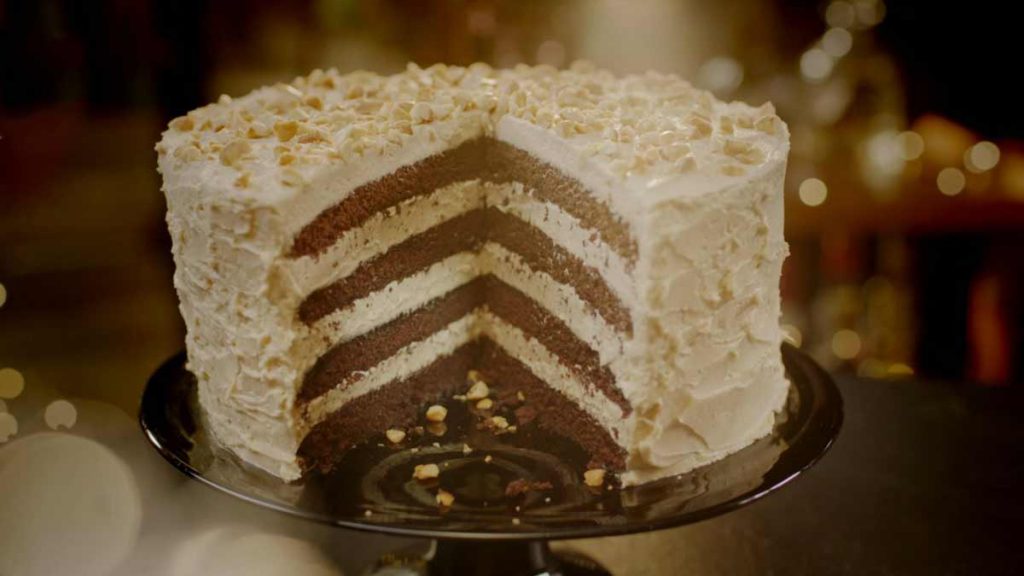

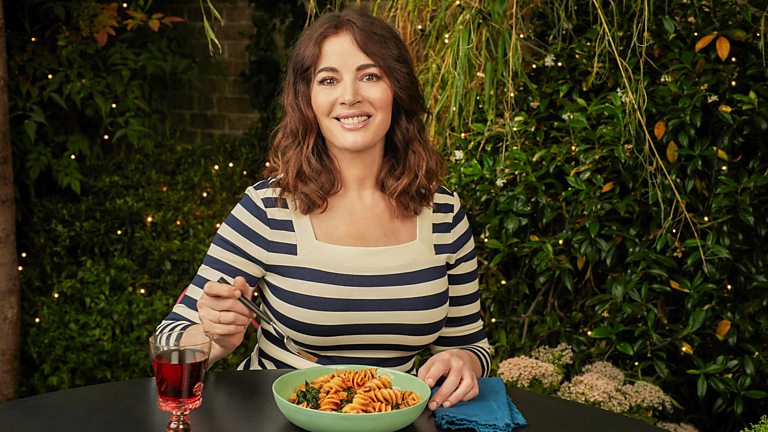
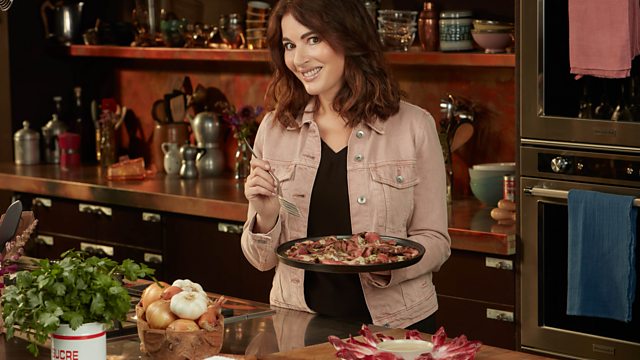
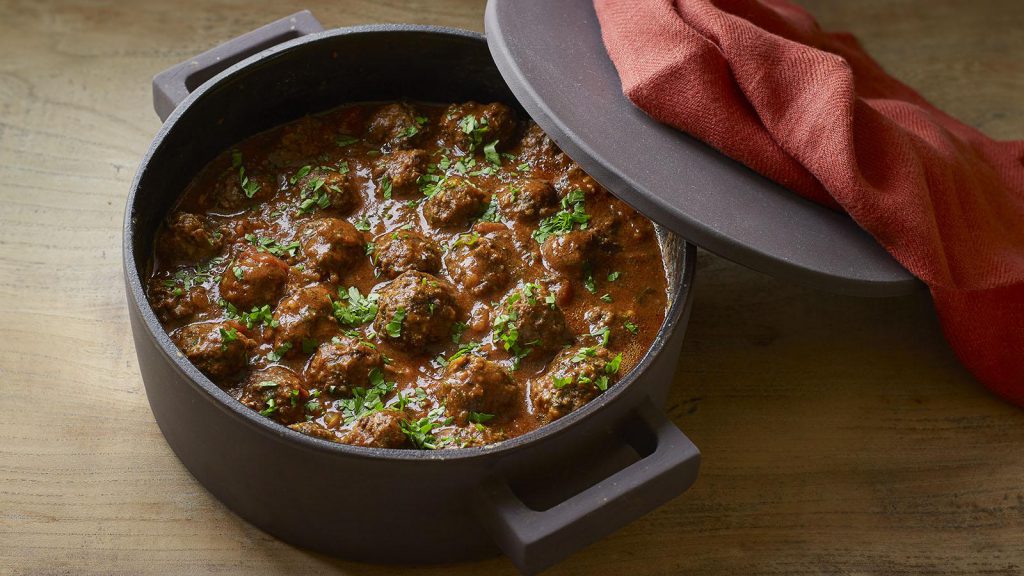
Pingback: Nigella’s Cook, Eat, Repeat episode 4 — HDclump